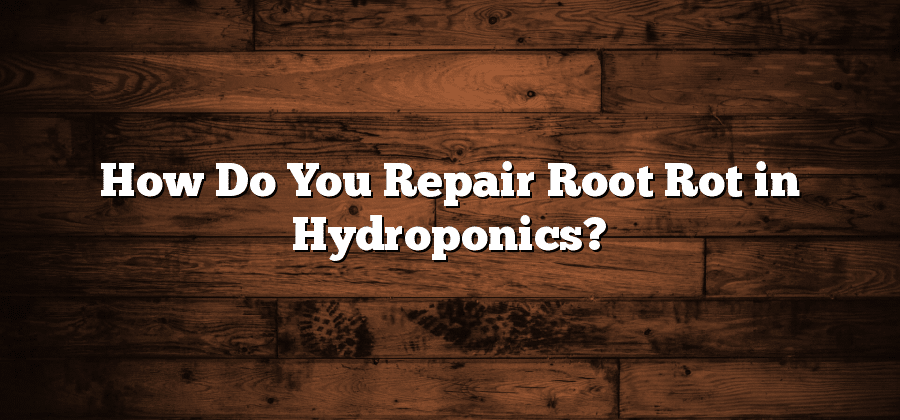Identifying the Symptoms of Root Rot
Root rot is a common problem faced by hydroponic growers, and identifying its symptoms is crucial in order to take prompt action. One of the most noticeable signs of root rot is a foul odor emanating from the roots or the hydroponic system. This odor often resembles that of decaying matter, indicating the presence of harmful bacteria or fungi. Additionally, affected roots may appear discolored or slimy, with a dark brown or blackish hue. The root tissue may also become mushy or soft to the touch, indicating advanced stages of root rot. It is important to regularly inspect the roots of your hydroponic plants, as early detection of these symptoms can prevent the spread of the disease and save your crop.
Another symptom to watch out for is the wilting or yellowing of leaves, often starting from the lower parts of the plant. This occurs because root rot inhibits the plant’s ability to absorb water and nutrients effectively, leading to dehydration and nutrient deficiencies. As the disease progresses, the discoloration and wilting may spread throughout the plant, eventually resulting in stunted growth or the death of the entire crop if left untreated. Vigilance in monitoring the overall health of your hydroponic plants and taking note of any unusual changes in leaf color or texture can help you identify root rot early on and intervene to salvage your crop.
Understanding the Causes of Root Rot in Hydroponics
One of the key factors that can contribute to the development of root rot in hydroponics is **excessive moisture**. In a hydroponic system, where the roots are constantly submerged in water, it is important to maintain a delicate balance of moisture levels. When the roots are consistently inundated, it can create an ideal environment for the growth of harmful pathogens, such as various species of **Pythium** and **Phytophthora**, which are known to cause root rot.
Another cause of root rot in hydroponics is **poor drainage**. If the hydroponic system does not have a proper drainage system, the excess water cannot be effectively removed, leading to water-logging and subsequent root rot. It is crucial to ensure that the system allows for adequate drainage, preventing the accumulation of excess water around the roots. Additionally, **improper nutrient concentrations** can also contribute to the development of root rot. When the nutrient solution is not properly balanced, it can lead to an overabundance of certain nutrients, which can create an imbalanced ecosystem favorable for root rot pathogens.
To effectively manage root rot in hydroponics, it is essential to understand and address these underlying causes. By maintaining appropriate moisture levels, ensuring proper drainage, and carefully monitoring nutrient concentrations, hydroponic growers can reduce the risk of root rot and promote healthier root systems for optimal plant growth.
Prevention Measures to Avoid Root Rot in Hydroponics
Root rot can be devastating for hydroponic systems, causing significant damage to the root system and potentially leading to the death of the plants. However, with the right prevention measures in place, it is possible to avoid this frustrating and costly problem altogether.
One of the most crucial prevention measures is maintaining proper **aeration in the hydroponic system**. By ensuring there is enough oxygen available to the roots, you can effectively prevent the growth of anaerobic bacteria that thrive in low-oxygen environments and cause root rot. This can be achieved by using **airstones or air pumps** to introduce oxygen into the nutrient solution. Regularly checking and cleaning the airstones or air pumps is also important to ensure they are functioning optimally.
Another effective way to prevent root rot is by maintaining **proper nutrient balance** in the hydroponic system. This involves regularly monitoring the nutrient solution’s pH and **conductivity levels** and adjusting them as needed. Nutrient solutions that are too acidic or too alkaline can create an unfavorable environment for the roots and promote the growth of pathogens that cause root rot. Additionally, keeping the nutrient solution properly balanced with essential nutrients such as nitrogen, phosphorus, and potassium will support healthy root growth and reduce the risk of infection.
Step-by-Step Guide to Diagnosing Root Rot in Hydroponic Systems
To diagnose root rot in hydroponic systems, it is essential to closely observe the plant’s roots for any signs of disease. Begin by carefully removing the plant from its grow medium, taking care not to damage the delicate roots. Gently rinse the roots with water to remove any dirt or debris, making it easier to examine them. Take note of any discoloration, such as brown or black patches on the roots. This is a clear indication of root rot, caused by fungal pathogens that thrive in overly wet conditions.
Next, examine the roots for any signs of decay or mushiness. Healthy roots should be firm and white, while rotted roots will appear soft and discolored. A pungent odor may also be present, further confirming the presence of root rot. If only a few roots show signs of rot, carefully trim them off using sterilized pruning shears. However, if a significant portion of the roots are affected, it may be necessary to reconsider the entire growing system and take immediate action to address the root rot problem.






